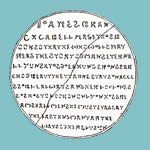James Branch Cabell : An Illustrated Bibliography
THE CREAM OF THE JEST: A Comedy of Evasions
James Hall Code |
Description |
CoJ-A1 |
|
CoJ-A2 (K) |
|
CoJ-A3 (K) |
Third Printing 1920 |
CoJ-A4 (K) |
|
CoJ-A5 (K) |
|
CoJ-A6 (K) |
|
CoJ-A7 (K) |
|
CoJ-A8 (K) |
|
CoJ-A9 (K) |
|
*CoJ-A9a (K) |
|
CoJ-B1 (E) |
|
CoJ-B1 (E) |
|
CoJ-B2 (E) |
|
CoJ-B2a (E) |
|
CoJ-B3 (E) |
Third English Printing 1923 |
CoJ-C1 (P) |
|
CoJ-C2 (P) |
|
CoJ-C3 (P) |
|
*CoJ-C4 (P) |
|
CoJ-D1-*9 (ML) |
|
CoJ-E1 (S) |
|
CoJ-E2 (RS) |
|
CoJ-F1 (w) |
|
*CoJ-F1a (w) |
|
*CoJ-F2 (w) |
|
*CoJ-F2a (w) |
Ballantine/Del Rey Paperback Edition, Second Canadian Printing 1979 |
*CoJ-G1 (E) (w) |
|
*CoJ-H1 (w) |
|
*CoJ-H2 (w) |
|
*CoJ-Ger-1 (w) |
The Sigil of Scotia:
Felix Kennaston's mystical talisman, the Sigil of Scotia, is revealed to be (in the mundane realm at least) nothing more than the lid of a cold cream jar. When Cabell's drawing of the sigil is inverted, though, as it is shown at left, a bit more information is revealed. The incription reads:
Bibliographic notes for the Kalki printings:
The 1917 first printing has the frontispiece (the Sigil of Scotia) is its expected place opposite the recto of the title page. Printings two through eight reverse the order of the frontispiece and the Books by Mr. Cabell page. The ninth Kalki printing returns the frontispiece to its original location.
There is a gilt square box printed on the spine between the title and the author's name on the first printing. This device persists through the fifth printing. It disappears with the sixth and later printings. No other title in the Kalki binding has this feature.
The fifth printing restructures the entire text and adds a new introduction by Harold Ward.
Beginning with this printing, the page count drops from 28o to 256, due to a slightly smaller font and reduced margins.
The first through the fourth printings have 38 Roman chapters, which renumber at the start of each book. In the fifth and later printings, there are still six Books, but the chapters are numbered continuously I through XL. What was formerly Harrowby's Preface becomes Chapter I, Palliation of the Gambit, of Book I, which now has seven chapters instead of the previous six. The following chapters are advanced accordingly to bring the total to 39.
With the Storisende Edition of The Cream of the Jest, CoJ-E1 (S), published in 1930, Cabell altered the ending of the novel. However, the ninth Kalki printing, CoJ-A9 (K), also published in 1930, still carries the original ending. This put this title in the interesting position of having two distinctly different versions of its story on retail shelves at the same time.
